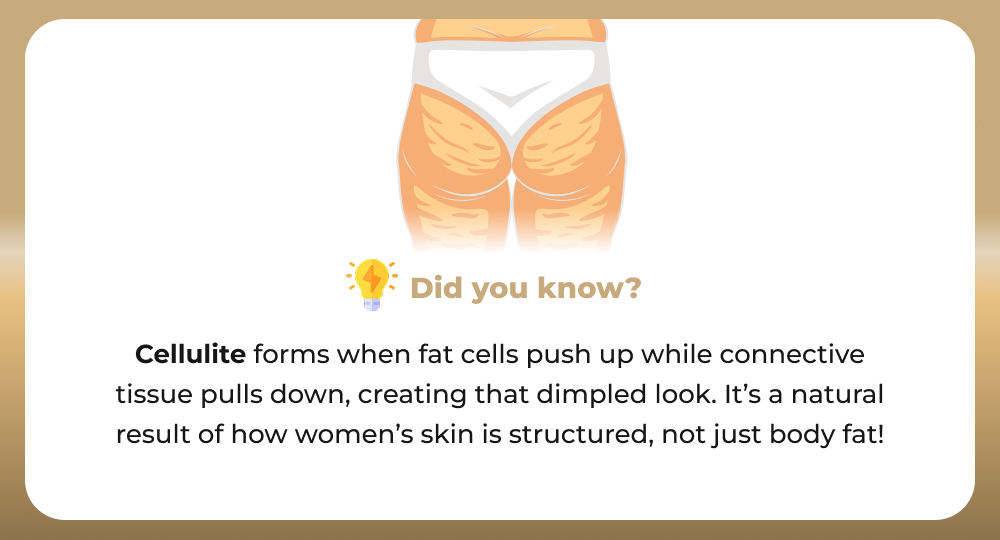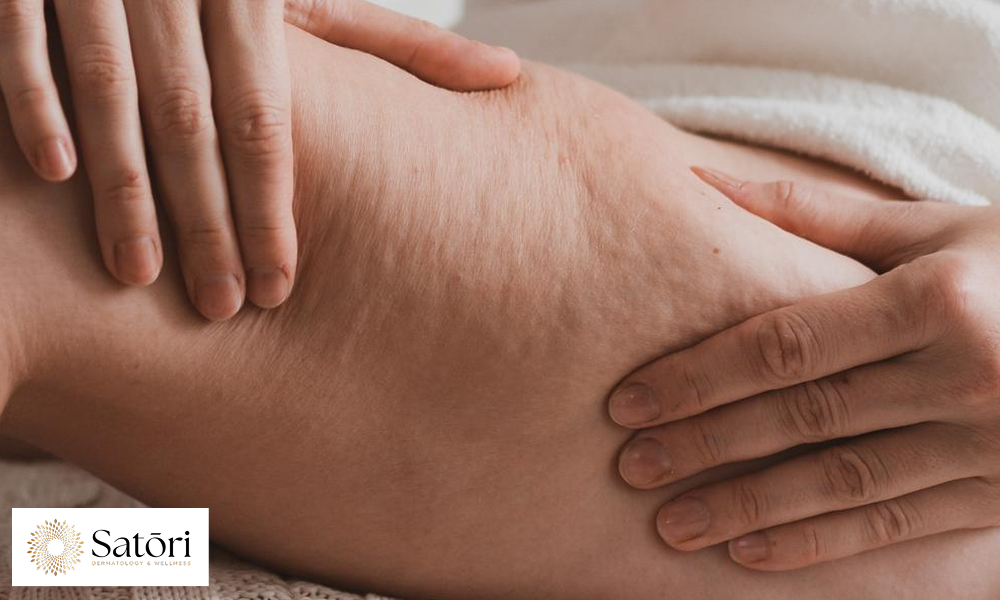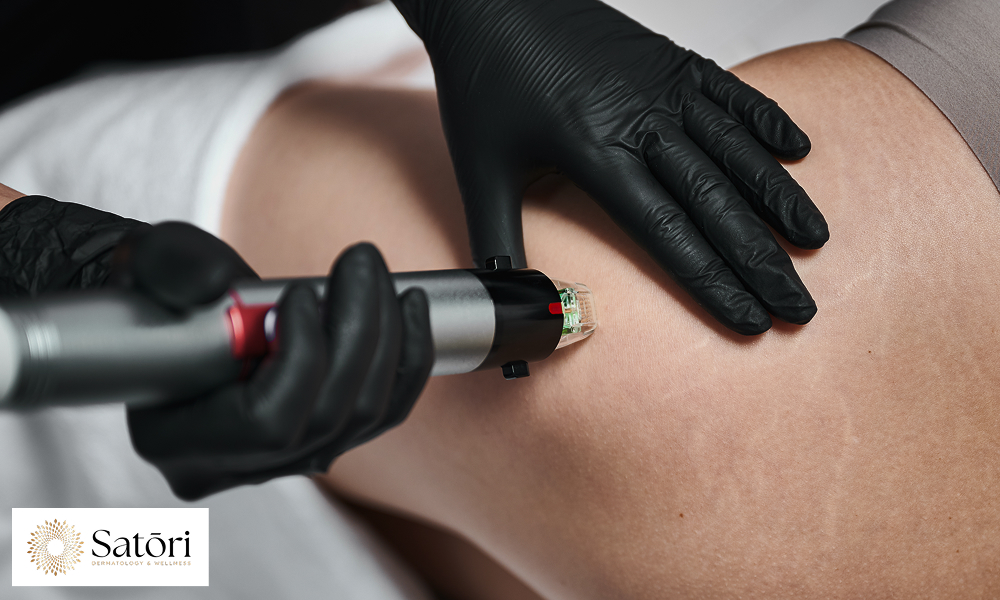If you’ve ever stood in front of a mirror and wondered why those dimples on your thighs seem so stubborn, you’re certainly not alone. In fact, you’re part of a sisterhood that includes 80-90% of women worldwide.
As a dermatologist in Franklin, TN, I’ve had countless conversations with patients who feel frustrated, self-conscious, and sometimes even defeated by cellulite. But here’s what I want you to know: understanding how cellulite forms is the first step toward making peace with your body and discovering effective solutions.
Cellulite isn’t a flaw or a failure on your part—it’s a completely normal structural characteristic of how female bodies store fat.
Today, I want to walk you through the fascinating science behind cellulite formation, explain why it’s so persistent, and most importantly, share the hope that comes with modern treatment options. You deserve to feel confident and beautiful in your own skin, and knowledge is your most powerful tool in that journey.

The Science Behind Cellulite Formation
To understand cellulite, we need to take a gentle dive into your skin’s architecture. Think of your skin as a beautifully complex three-story building. The top floor is your epidermis—the protective outer layer you see and touch. The middle floor is your dermis, packed with collagen, elastin, blood vessels, and nerves. The basement level is your subcutaneous layer, where fat cells live in organized compartments.
In women, these fat compartments are arranged in vertical columns, separated by connective tissue septa that act like walls. When fat cells expand—whether due to weight gain, hormonal changes, or simply genetics—they push upward against the dermis. Meanwhile, the connective tissue septa pull downward, creating that characteristic dimpled appearance we call cellulite.
This is fundamentally different from men’s fat storage system, where the connective tissue forms a crisscross pattern that better contains expanding fat cells. It’s not fair, but it’s biology. The undulating, cottage cheese-like texture of cellulite is simply the visual result of fat cells pushing up while connective tissue pulls down.
What makes this even more complex is that collagen and elastin—the proteins that keep your skin firm and elastic—naturally decrease as we age. This means the “ceiling” above those fat compartments becomes less supportive over time, making cellulite more visible even without significant weight changes.

Why Cellulite Develops
Cellulite formation isn’t caused by a single factor—it’s the result of multiple influences working together. Understanding these contributors can help you feel less frustrated and more empowered about your body’s natural processes.
The key factors include:
- Hormonal influences: Estrogen plays a significant role in cellulite development by affecting fat storage, circulation, and collagen production. This is why cellulite often appears or worsens during puberty, pregnancy, and menopause. Insulin and thyroid hormones also contribute to how and where your body stores fat.
- Genetic predisposition: Your family history significantly influences your likelihood of developing cellulite. If your mother or grandmother had cellulite, you’re more likely to develop it too. This includes inherited factors like skin thickness, fat distribution patterns, and connective tissue structure.
- Lifestyle factors: While cellulite isn’t solely caused by lifestyle choices, factors like prolonged sitting, lack of exercise, poor circulation, and high-stress levels can contribute to its development and visibility.
- Age-related changes: As we mature, our skin becomes thinner, less elastic, and more prone to showing the underlying fat compartment structure. Muscle mass also naturally decreases, which can make cellulite more apparent.
Cellulite can affect women of all sizes and fitness levels. I’ve treated marathon runners and yoga instructors who struggle with cellulite, just as I’ve helped patients who are beginning their wellness journeys. Your cellulite doesn’t reflect your worth, your discipline, or your health—it reflects your humanity.
Why Cellulite Resists Treatment
Here’s the compassionate truth I share with every patient: cellulite is stubborn because it’s a structural issue, not simply a fat storage problem. This is why those expensive creams promising miraculous results often disappoint, and why diet and exercise alone—while wonderful for overall health—don’t typically eliminate cellulite completely.
The challenge lies in the fact that cellulite exists in the deeper layers of your skin, where topical treatments struggle to penetrate effectively. Even the most potent creams can only address surface-level concerns, while the root cause lies in the relationship between fat cells and connective tissue beneath.
Additionally, you can’t spot-reduce fat through exercise or diet but there are some ways exercise can compliment cellulite reduction treatment. While maintaining a healthy weight can minimize cellulite’s appearance, the underlying structural components remain unchanged. This is why some women notice that even significant weight loss doesn’t eliminate their cellulite—and why that’s completely normal.
The marketing industry has unfortunately created unrealistic expectations about cellulite treatment, promising overnight transformations that simply aren’t possible with the current understanding of skin physiology. This has led many women to feel like they’re failing when treatments don’t work as advertised, when the truth is that the treatments themselves were overpromised.

Hope and Modern Solutions
While cellulite may be persistent, it’s not untreatable. Modern dermatology offers several evidence-based approaches that can significantly improve cellulite’s appearance when administered by trained professionals. The key is understanding that effective cellulite treatment typically requires a combination approach and realistic timelines.
Professional treatments like radiofrequency therapy, laser treatments, and minimally invasive procedures can target the structural components of cellulite. These treatments work by stimulating collagen production, improving circulation, and sometimes physically releasing the tight connective tissue bands that create dimpling.
What excites me most about current cellulite treatments is their focus on gradual, natural-looking improvements. Rather than promising dramatic overnight changes, these approaches work with your body’s natural healing processes to strengthen skin structure and improve texture over time.
I’ve witnessed patients transform not just their skin, but their confidence.
The most successful treatments combine professional procedures with a holistic approach to skin health, including proper hydration, regular movement, and stress management. This isn’t about perfection—it’s about helping you feel comfortable and confident in your body.
Embracing Your Journey to Confidence
Understanding how cellulite forms and why it’s challenging to treat isn’t meant to discourage you—it’s meant to empower you with realistic expectations and genuine hope. Your cellulite doesn’t define your beauty, your health, or your worth, but if it affects your confidence, know that effective options exist.
The journey to feeling comfortable in your skin is deeply personal, and there’s no right or wrong path. Some women choose professional treatments, others focus on self-acceptance, and many find a combination approach that works for them. Whatever path resonates with you, remember that you deserve to feel confident and beautiful exactly as you are.

